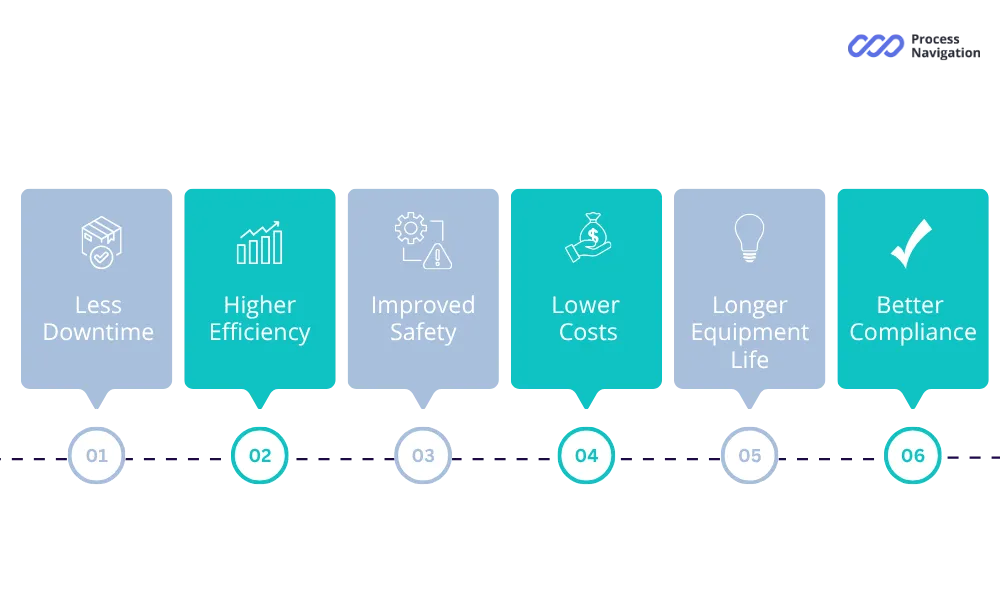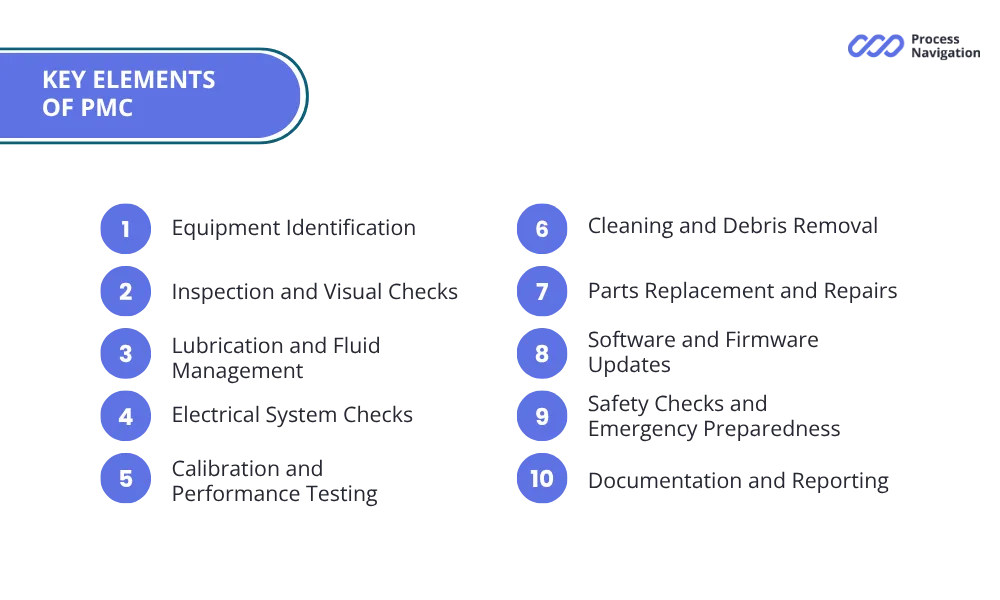You came to work on Monday morning and the main production line is stopped. The cause? A breakdown of critical equipment that could have been prevented by a basic checkup a month ago. Unfortunately, these scenarios happen in companies around the world every day.
This approach supports a strong preventive maintenance program that minimizes risks and unplanned downtime.
Modern manufacturing requires flawless operation of equipment. Unplanned downtime can cost a company thousands of dollars per hour, not to mention lost opportunities and damaged reputation. That’s why preventive maintenance becomes not just desirable, but a critical element of a successful business that helps prevent equipment failure and reduce costly repairs.
What is the Equipment Maintenance Checklist?
The equipment maintenance checklist is a structured list of maintenance tasks and checks that must be performed on a regular basis to keep your equipment in working order. It is a well thought out system that helps prevent breakdowns before they occur and improves equipment reliability.
The basic idea behind preventive maintenance is that it is much cheaper and more effective to prevent breakdowns than to fix them. The checklist becomes your guide in this process, providing a systematic approach to maintenance workflows and helping preventive maintenance ensures consistent task execution.
All records should be documented in an equipment maintenance log to ensure traceability and compliance with industry regulations and provide a clear maintenance history.
Benefits of Using Preventive Maintenance Checklists

Reducing Unplanned Downtime
Statistics show that properly organized preventive maintenance can reduce unplanned downtime by 70-80%. This is achieved by detecting potential problems early, when they can still be solved without stopping production. An organized preventive maintenance checklist also helps avoid unexpected equipment failures.
Increased equipment life
Regular maintenance using preventive maintenance checklists helps equipment operate at optimal performance, which significantly extends its lifecycle. Some companies have seen a 20-30% increase in equipment life.
Cost Savings
Although preventive maintenance requires an investment, it pays for itself many times over. The cost of scheduled maintenance is usually 3-5 times lower than the cost of emergency maintenance. Applying a solid maintenance checklist helps identify and replace worn components before they cause failures.
Improved Safety
Regular inspections help identify potentially dangerous situations before they become a threat to personnel. This is especially important for industrial equipment and verifying safety features, safety and caution areas, and the availability of safety equipment.
Better Compliance
Many industries require a documented approach to equipment maintenance. Checklists help you comply with ISO, OHSAS and other standards, supporting the entire maintenance program and your organization’s facility infrastructure.
Essential Elements of Machine Preventive Maintenance Checklist
Customizing checklists for each piece of equipment ensures maintenance procedures, frequency and components address the unique characteristics and manufacturer recommendations of each machine.
Make sure to include all aspects of facility infrastructure like HVAC, plumbing, electrical, fire protection and security systems to have a comprehensive maintenance plan.

Equipment Identification
| Field | Required Information | Purpose |
| Machine Name | Official equipment designation | Clear identification |
| Model Number | Manufacturer’s model | Parts ordering |
| Serial Number | Unique identifier | Warranty tracking |
| Location | Physical placement | Quick location |
| Installation Date | When equipment was installed | Age tracking |
| Last Maintenance | Previous service date | Schedule planning |
| Assigned Technician | Responsible person | Accountability |
Inspection and Visual Checks
Routine inspections help detect early signs of wear and tear before they turn into bigger problems. Consider adding a predictive maintenance checklist for high-value or complex machines. Use an inspection checklist during routine assessments to catch early signs of failure:
| Inspection Category | What to Check | Frequency |
| Fluid Systems | Oil/fluid leaks, contamination | Daily |
| Mechanical Components | Loose bolts, worn belts, seals | Weekly |
| Structural Integrity | Cracks, rust, corrosion | Monthly |
| Performance Indicators | Unusual vibrations, noises | Daily |
| Safety Systems | Emergency stops, guards | Weekly |
These inspections are crucial, especially for material handling equipment, to keep operations running smoothly and extend equipment lifespan.
Lubrication and Fluid Management
Proper lubrication minimizes friction and prevents overheating. Regular checks should include:
- Monitoring and replenishing oil levels
- Greasing bearings and joints
- Inspecting coolant and hydraulic fluid levels.
Electrical System Checks
Electrical issues are a common cause of breakdowns, so it’s essential to check:
| Component | Check Frequency | Action Items |
| Circuit breakers | Monthly | Test operation, clean contacts |
| Wiring connections | Quarterly | Tighten, inspect for wear |
| Battery systems | Monthly | Voltage, corrosion, terminals |
| Control panels | Weekly | Clean, check displays |
| Motors | Monthly | Temperature, vibration, current |
Calibration and Performance Testing
To maintain accuracy and efficiency, machines should be periodically tested. This includes:
- Verifying alignment and calibration of key components
- Running test cycles to detect irregularities
- Measuring speed, pressure, or temperature variations.
Regular calibration helps enhance operational efficiency and ensures equipment performance meets production standards.
Cleaning and Debris Removal
Dust and debris buildup can clog moving parts and decrease efficiency. Preventative cleaning should involve:
- Clearing dust from ventilation systems.
- Cleaning or replacing filters and air intakes.
- Wiping down surfaces to prevent corrosion.
Maintenance teams should regularly replace air filters and maintain clean working environments to prevent worn or damaged components.
Parts Replacement and Repairs
Proactive replacement of worn-out components can prevent costly failures. Regular checks should cover:
- Tightening or replacing bolts and fasteners.
- Inspecting and changing air filters.
- Replacing worn-out belts, gaskets, and hoses.
Software and Firmware Updates
For computerized or automated systems, keeping software up to date is crucial. Make sure to:
- Regularly update software and firmware.
- Check for compatibility issues.
- Run diagnostic tools for system performance.
Maintenance activities should include regular software updates to maintain operational efficiency and prevent system failures.
Safety Checks and Emergency Preparedness
Safety is a top priority. Routine checks should ensure:
- Emergency stop functions are operational.
- Fire suppression systems are in working order.
- Personal protective equipment (PPE) is available and in good condition.
Maintenance teams should also check carbon monoxide detectors and other safety features as part of their routine maintenance activities.
Documentation and Reporting
Keeping thorough records of all maintenance activities helps with compliance and future troubleshooting. Essential documentation should include:
- Date of maintenance.
- Issues detected.
- Actions taken.
- Technician’s notes and signature.
Maintenance managers use these records to track key performance indicators and monitor equipment reliability.
Types of Preventive Maintenance Sheets
The right checklist depends on the equipment and specific maintenance needs. Here are four of the most common checklists:
Pass-or-Fail Checklist. A pass/fail checklist is a simple yet effective tool for verifying that routine maintenance tasks are completed. This maintenance checklist format is ideal for quick inspections, like checking fluid levels or identifying visible signs of wear and damage. It ensures that no essential maintenance steps are missed.
Step-by-Step Checklist. For more complex maintenance tasks, a step-by-step checklist provides detailed, structured instructions. This type of machine maintenance checklist template is useful for tasks such as repairing equipment or performing comprehensive system maintenance. By breaking the process into clear, manageable steps, it helps maintenance teams complete tasks accurately and efficiently.
Time-based Checklists. These daily preventive maintenance checklists help take care of equipment regularly so it doesn’t break and lasts longer. Maintenance scheduling is planned for specific times – every month, quarter, or year, following predetermined maintenance frequency guidelines.
Usage-based checklists. These lists connect maintenance with how much the equipment is used. This helps avoid breakdowns from wear. Work is planned based on how many hours the equipment worked, how many cycles it completed, or other usage measures. This approach helps optimize maintenance intervals and prevents equipment downtime.
How to Create an Effective Checklist
| Step | Description |
| 1. Equipment Analysis | Start by making a complete list of all equipment in the facility. For each item, identify: – Technical documentation – Manufacturer’s recommendations – Criticality to production – Breakdown history. |
| 2. Determine maintenance tasks | For each piece of equipment, make a list of work required: – What to check – How to check – What tools to use – Condition assessment criteria. |
| 3. Set Frequency | Determine how often each task needs to be performed. Take into account: – Manufacturer’s recommendations – Operating conditions – Experience with previous breakdowns – Equipment criticality. |
| 4. Create a checklist format | Develop an easy-to-use form to record inspection results: – Clear wording of tasks – Space for completion marks – Fields for comments – Signature of performer. |
Digitalization of the Service Process
Modern technologies allow you to significantly improve the process of preventive maintenance.
Advantages of digital checklists:
- Automatic reminders — the system will prompt itself when it’s time to perform maintenance.
- Mobile access — workers can use tablets and smartphones right at the workplace.
- CMMS integration — link to maintenance management systems.
- Data analytics — the ability to analyze trends and optimize maintenance.
Popular solutions:
- Specialized CMMS systems.
- Mobile service applications.
- Cloud-based asset management platforms.
If your organization is considering creating a preventive maintenance checklist to support its larger proactive maintenance strategy, consider how ProcessNavigation’s digital platform can elevate standardization processes to higher levels of effectiveness. ProcessNavigation consolidates all elements by combining instructions, checklists, responsibilities, and tasks into a single transparent system.
The platform uses digital workflows, task management, and machine maintenance tools for better efficiency and reduced downtime, helping optimize maintenance program and empower teams to operate safely, accurately, and efficiently. This ensures machines run efficiently and safely, reduces equipment downtime and accidents through structured preventative maintenance program.
System Implementation: Step-by-step Plan
| Stage | Timeframe | Work direction | Key tasks |
| 1. Preparation | 1-2 months | Current status analysis | Equipment inventory Evaluation of existing procedures Identification of problem areas Prioritization |
| Team building | Assignment of responsible persons Staff training Assignment of responsibilities Creation of working groups | ||
| 2. Development | 2-3 months | Creating checklists | Developing standards Creating forms and templates Testing at pilot sites Adjusting procedures |
| Technology implementation | Software selection. System customization Integration with existing systems User training | ||
| 3. Pilot launch | 1-2 months | System testing | Launch at individual sites Collect feedback Identify problems Adjust procedures |
| 4. Full implementation | 2-3 months | Scaling | Enterprise-wide rollout Training of all staff Setting KPIs and metrics Setting up control processes |
Facility managers should work closely with maintenance technicians during implementation to ensure a smooth transition and proper training on the new preventive maintenance schedule.
Typical Mistakes and How to Avoid Them
- Mistake 1: Checklists are too complicated
Problem: Time-consuming checklists overloaded with details.
Solution: Focus on the critical checks. It’s better to perform a simple checklist regularly than a complex one on an ad hoc basis. Create an effective preventive maintenance checklist that prioritizes specific maintenance tasks.
- Mistake 2: Lack of staff training
Problem: Employees don’t understand how to properly use checklists.
Solution: Invest in training. Hold regular trainings and create visual instructions. Train staff on machine maintenance procedures and the importance of preventive maintenance.
- Mistake 3: Ignoring feedback
Problem: Maintenance checklists are not adjusted based on user experience.
Solution: Regularly collect feedback from implementers and improve procedures. Use feedback to optimize maintenance frequency and improve proper maintenance practices.
- Mistake 4: Insufficient follow-up
Problem: Lack of verification that all checklist items are actually being followed.
Solution: Install a follow-up system and conduct regular audits. Implement a system to track maintenance tasks and ensure all preventive maintenance tasks are completed on schedule.
FAQ
Maintenance checklists should be reviewed at least once a year or when conditions change, equipment is upgraded, or after major breakdowns. It is also a good idea to collect feedback from performers on a monthly basis to make minor adjustments. This helps prevent costly downtime and ensures preventive maintenance reduces the likelihood of failures.
The basic structure can be standardized, but the content should be tailored to the specific equipment. Universal checklists may miss specific features of the equipment, which will reduce the efficiency of the service. Consider the unique requirements of hydraulic and pneumatic systems when creating equipment-specific checklists.
Full implementation usually takes 6-12 months depending on the size of the company and complexity of the equipment. A pilot project can be launched in 2-3 months, and the first results will become visible 3-6 months after the start of use. This timeline includes training maintenance personneland establishing proper maintenance program procedures.
Include escalation procedures in the checklist: immediate shutdown of equipment for critical problems, notification of management, and calling in specialists. It is important to clearly identify which problems require immediate response and which can be scheduled for routine maintenance. This helps prevent equipment failure and avoid costly repairs.
Repairs involve fixing equipment that has already broken down or stopped working properly. Maintenance consists of preventive steps such as regular maintenance, fine-tuning, and part replacements that are done before problems occur. Effective maintenance helps prevent costly repairs and major fixes, while corrective maintenance addresses issues after they occur. A well-structured preventive maintenance plan helps minimize the need for emergency maintenance and reduces overall maintenance costs.
-
 Maintenance Plan: What Is It And How Does It Work
Maintenance Plan: What Is It And How Does It WorkIn modern manufacturing, equipment downtime costs businesses thousands of dollars an hour. The difference between...
Technology
-
 Competency Management
Competency ManagementModern businesses face a big challenge: how do you ensure every employee has the skills...
Technology
-
 Unlocking the Benefits of Total Quality Management
Unlocking the Benefits of Total Quality ManagementIn today’s competitive world, the quality of products and services is becoming the key to...
Technology
